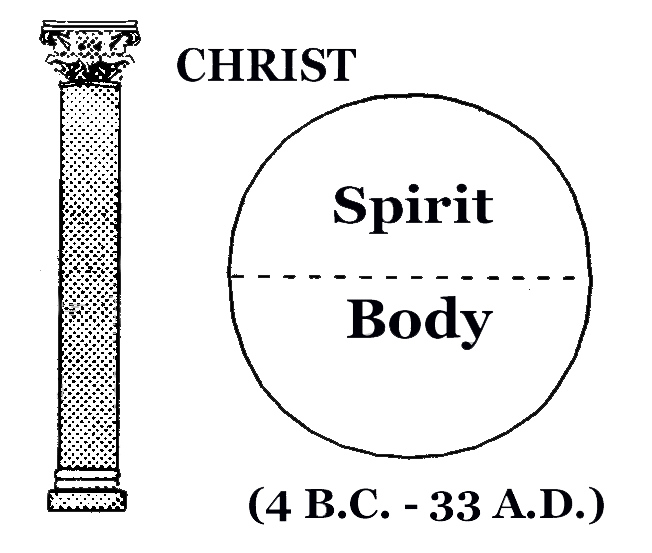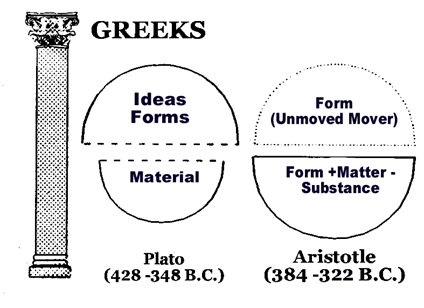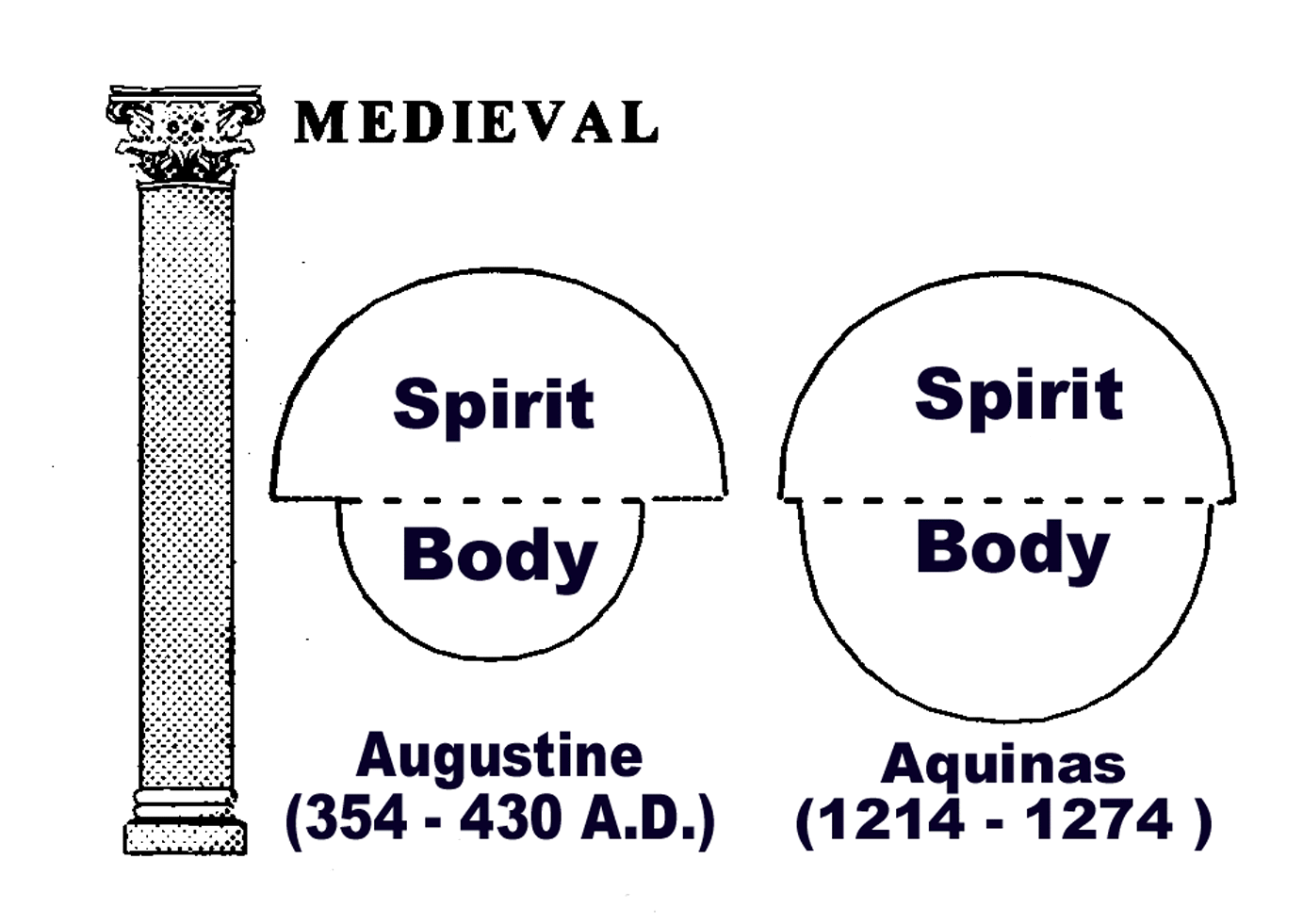The Flow of Western CultureRich Milne
Philosophy in the West has its systematic beginnings in the works of Plato and Aristotle. A. N. Whitehead's comment that "All of Western philosophy is a series of footnotes to Plato"{4} is not much of an exaggeration, especially if one also includes Aristotle in the sentence. Their centrality and whole philosophy are brilliantly summed up in a famous fresco in Rome. In one great wall of color, it lays out the two polarities of Western thought over the last two thousand years, up until our own century.
Until late in the nineteenth-century Raphael was considered by most critics to have been the greatest painter in history. This masterpiece is found in the Vatican Palace. The focus of the picture is the twin figures of Plato (said to be modeled after Leonardo) and Aristotle. Plato points up, to where the eternal Forms must be, and Aristotle points down, to this world, where in his view we must find meaning among the particulars. These are the two philosophers who, between them, created the foundations of philosophy. Let us examine each of them more closely.
As could happen only once in the history of Western thought, a teacher and his student set the course for a whole discipline until the present day. In nearly 2,500 years the answers have changed remarkably, but even more remarkable is the fact that the questions have not changed at all. Plato was the first thinker we know of who attempted to synthesize the thought of his predecessors, and his grand synthesis is still an object of discussion today. Plato took the competing systems that came before him and produced a new answer. Whereas those who followed Heraclitus saw the only true reality as the constancy of change, the disciples of Parmenides held that change was an illusion, that only the permanent has substance. How could these two views be brought together? Plato's answer is the first, and among the greatest, attempts at a grand synthesis, a bringing together of all of human thought and expression into one more or less coherent world view. In this world, Plato said, Heraclitus was indeed right. Change was real and characterized everything in this life. But, Plato cautioned, there is another world, more real than this one. And in the world of ideas, or forms, there is no change. All ideas are permanent, so Parmenides too is correct. This becomes what is referred to as a dualistic system: there are two realities, not just one monistic whole. Both the present world of change, of coming into being and ceasing to be, and the eternal world of unchanging ideas, of pure concepts, of essence without material embodiment, are real. There is a world of matter and a world of spirit. Whether this dualism is real or not is one of the great arguments in intellectual history. Christianity is dualistic. Eastern philosophies tend to be monistic. Along with this dualism came an emphasis on the eternal as the important. Dean Inge states that it is through Plato "that the conception of an unseen eternal world, of which the visible world is but a pale copy, gains a permanent foothold in the West. . . . The call, once heard, has never long been forgotten in Europe."{5} In Plato's conception of reality, there are forms beyond this world: "that which imparts truth to the known and the power of knowing to the knower is what I would have to term the idea of the good."6
If Plato brings to the Western world the idea of a world beyond this world, and good as its highest ideal, then Aristotle returns us to the consideration of things firmly planted in this world. A student of Plato's for nearly twenty years, Aristotle none-the-less initiated the other great school of classical philosophy that is still much in evidence today. Bertrand Russell's critical assessment was, "Ever since the beginning of the seventeenth century, almost every serious intellectual advance has had to begin with an attack on some Aristotelian doctrine; in logic this is still true today."{7} In place of Plato's emphasis on forms, Aristotle focused on the causes of material objects. Aristotle distinguished four causes: the material cause, the formal cause, the efficient cause, and the final cause. These explain what something is made of, what it is patterned after, who made it, and for what purpose. It is to Aristotle that we owe the subject divisions that we still use today even in conversation. Aristotle either invented or described
the subjects of logic, metaphysics, politics, ethics, rhetoric, psychology, physics, biology, meteorology. He gave us our distinctions between theoretical and practical, intellectual and moral, potential and actual; our classification of forms of government into constitutional and tyrannical, monarchy, aristocracy, oligarchy, democracy; the central terms of logic such as syllogism, universals, substance. Aristotle is the source also of the moral vocabulary of Europe, so incomparably rich in refined distinctions-between motive and intention, behavior and character, between the generous and the magnanimous man, the courageous and the reckless man, the wit and the buffoon, the friend and the lover.{8} But while he provided categories for the forms of the unseen world of Plato, he was not at all interested in a world above this one, but sought instead to ground his system in "this fixity within human life, not beyond." His interest in language and logic came from his passion to comprehend the diversity of this life, rather than look, as Plato had, for a unity beyond this life. That is why, in Raphael's picture, the hand of Plato points up and Aristotle, in quiet dissent, points out into the world. How do these two great thinkers find their way into the church? Through two of the greatest theologians in Christian history, Augustine and Aquinas.
Augustine was born, lived, and died in North Africa (in what is now Algeria), and was without doubt the church's greatest theologian after Paul. But before becoming a Christian Augustine experienced most of the attractions of sin, and thought through most of the attractive philosophies of the day as well. After his conversion, told with great candor and intense spiritual insight in his Confessions, Augustine retained for the rest of his life some of the thought forms of his past life, most especially neo-Platonism. At the same time he "Christianized" Plato to the extent that he could write: "But the true and highest good, according to Plato, is God, and therefore he would call him a philosopher who loves God."{9} This acceptance of Plato as the philosopher closest to understanding God by natural revelation, opens the door for much of Plato's thought to influence the church. In particular, the Platonic distinction between the mind as good and the body as base or bad, has plagued the church up to today. The belief that sex is evil, even in marriage, came from Augustine, who derived this from neo-Platonism. Augustine certainly had Platonic elements, but he was also profoundly different from him. From Neo-Platonism he was able to accept the idea that ideas can have existence, with eternal ideas existing in the mind of God. Also from Platonism came his view that evil is always a lack in something that is otherwise good, because all that God created is good. But history would be unimportant for a Neo-Platonist, whereas history is, for Augustine, a story of God's works in and love for, the world. A God who became incarnate would be impossible in Plato's system, but is the essence of Christianity. Divine revelation through a book would be totally outside the possibilities of Neo-Platonism, and philosophy, or unaided rational thinking cannot be the source of any real salvation, as it was for the Neo- Platonist. For Augustine it was the Bible that provided what may be known about God, not our own thoughts logically building up to a knowledge of the Good. As Thomas Aquinas himself said: "Whenever Augustine, who was imbued with the doctrines of the Platonists', found in their teaching anything consistent with faith, he adopted it; and those things which he found contrary to faith he amended."{10} Augustine also gave the church its focus on free will, which he denied, and sovereignty, which he made foundational. Any book on historical theology should have a chapter on Augustine. (The book by Deotis Roberts in the bibliography is a good start.)
Thomas was born and died in Italy, and divided his active teaching life between Paris and Italy. His five proofs for the existence of God relied heavily on Aristotle's causes, and it is through Thomas that Aristotle became a central 'authority' in the Church. Thomas saw a significant place for reason as we come to know God, but it never supplants faith. What Thomas saw clearly was that theological problems must be handled theologically, and philosophical problems required philosophical solutions. It will not do to mix these areas, and the problems of the past had been created by thinkers who had done exactly that. As Copleston points out, what Thomas enabled the church to see was "the rights and position of philosophy as a rational study distinct from theology."{11} Thomas rekindled the interest in philosophy as a systematic approach to knowledge, as well as the use of reason to defend the Gospel (1 Peter 3:15). But like so many applications of truth, this emphasis on reason also turned people's minds to the defense of human reason alone. In summation, Augustine could be seen as the beginning of the Medieval period (Rome is sacked in 410 during his lifetime), and the last medieval or first Renaissance thinker is Aquinas, who opens the church doors to the "new" philosophy of Aristotle.
For the first few hundred years the church was consolidating the faith, through the completion of the New Testament, the first church councils, and the growth of the church among the Gentiles. Church art quite quickly picked up characteristics of the Syrian culture around it, and many contemporary cultural expressions came into the church from the experiences of those who built the first small churches. But as Christianity became the religion of the Empire under Constantine, a revolution was on the way.
No large church buildings were built until after the Edict of Milan, in 312. St. Sophia is one of the first great churches built in the East. Built from A.D. 532 to 537 it is vast on any scale. We think of Gothic cathedrals as immense, but they are dwarfed by St. Sophia. The highest Gothic cathedral was Beauvais, but, at 157 feet, it collapsed. St. Sophia rises 183 feet to the top of its dome. It is higher than the Roman Pantheon in Rome. Gothic naves were never broader than about 50 feet. St. Sophia is 100 feet. The main area of the building is 220' by 107' through the full length. It is a building to inspire awe and reverence in anyone who enters. Whoever you are, you know you have walked into a building designed to magnify Someone greater than yourself. You look up and up, and if you are disposed to worship at all, this building will humble you before the mighty God. It was a Christian church for its first 916 years. Then, after the Turkish conquest of 1453, it became a Moslem mosque. The four slim minarets were added to it and the Christian mosaics were plastered over at that time. The idea of the building seems to be to shrink the individual into insignificance and to draw his or her thoughts upward to where reality is. The building seems to cry out: Don't be caught up in this petty world, but look up to the heavens and God. The early Christian basilicas were the successors to the secular architecture of Rome, rather than to the ancient temples (where the worshipers did not enter and so the buildings could be small). Greeks beautified the exteriors, Romans the interiors (e.g., the Baths of Caracalla). Byzantine basilicas were designed along the lines of the Greek cross.
St. Etienne of Bourges was started in 1195, finished about 1266, and consecrated in 1324. Aldous Huxley called it "the grandest, the most strangely and fabulously beautiful building in Europe."{12} "Seen from its gardens, all burly in its muscular shoulders of sustaining flying buttresses, impresses mainly by its posture of strength. There is nothing of the delicacy and grace that mark the outer ribbings of other Gothic cathedrals."{13} Calvin would later study at a university built here. While in the interior, the eye is carried upward by the very structure, and the grandeur leads one to meditation on the glories of heaven rather than earth. The cathedral was the earliest movie theater, with the darkness serving to focus one's attention on the stained glass windows, which retold the stories of the Bible, and of the faithful who were now in heaven with Christ. "By the lightness of its mass, the pyramidal composition of values, the skillful gradation of its upward lines, the cathedral of Bourges is perhaps, of all cathedrals, the one which conveys the most moving impression of Gothic art."{14}
|



